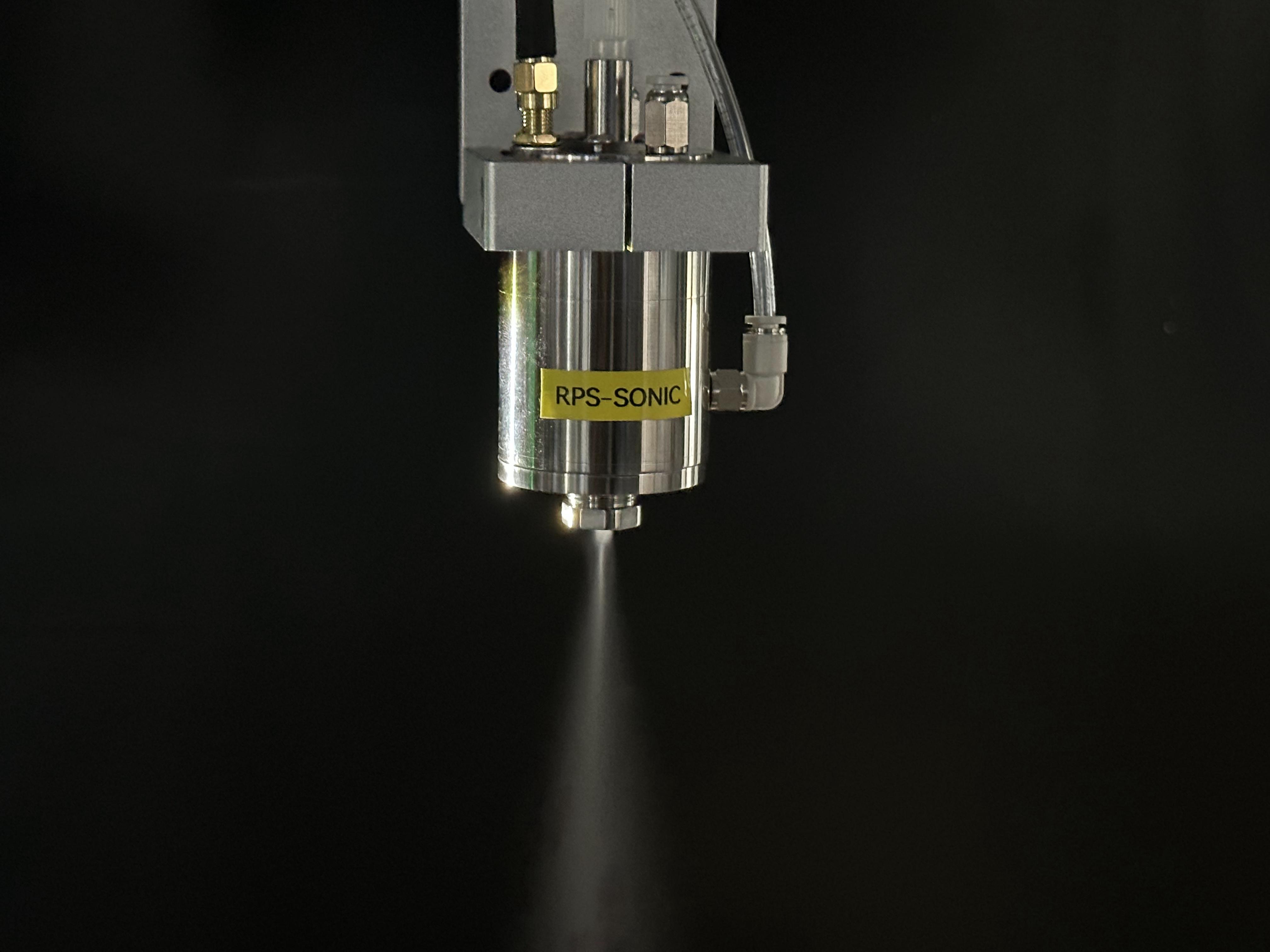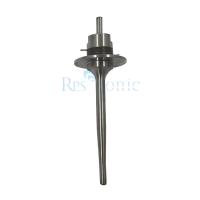50khz Ultrasonic Glue spray coating system spray nozzles
What is the ultrasonic spray nozzle?
An ultrasonic glue spray coating machine is a specialized device
designed to apply adhesive coatings using ultrasonic spray
technology. This machine is particularly useful in various
industrial applications where precision and efficiency are
critical.
Key Features
Ultrasonic Technology: Uses ultrasonic vibrations to create a fine
mist of adhesive, allowing for a uniform application without
overspray.
Adjustable Droplet Size: The droplet size can be controlled, which
is essential for different substrates and adhesive types.
High Efficiency: Reduces waste of adhesive material, leading to
cost savings and efficient use of resources.
Versatile Applications: Suitable for bonding materials in
industries such as automotive, electronics, textiles, and
packaging.
Automated Process: Often integrated into automated production
lines, enhancing speed and consistency in adhesive application.
Applications
Electronics: For applying adhesives in assembly processes, such as
securing components on circuit boards.
Automotive: Used for bonding and sealing components in vehicle
manufacturing.
Textiles: For applying adhesives in fabric lamination and bonding
processes.
Packaging: Efficiently applies adhesives in carton sealing and
package assembly.
Advantages
Reduced Material Waste: The precision of the ultrasonic spray
minimizes excess adhesive usage.
Improved Bonding Quality: Even coating enhances the quality of
bonds between materials.
Faster Production Rates: Automation and efficient spraying lead to
quicker processing times.
If you need more details about specific models, manufacturers, or
applications, let me know!

What is the parameter of the spray nozzle?
| Item | Wide type | Diffuse type | Bunching type | long nozzle | External fluid supply |
| Diameter of atomized particle | 15-40 | 15-41 | 15-42 | 15-20 | 15-20 |
| Spray width (um) | 40-120 | 40-80 | 2-20 | 1-3 | 0.5-2 |
| spray height (um) | 50-150 | 30-80 | 10-30 | 10-20 | 10-20 |
| Flow (ml/min) | 0.5-20 | 0.5-20 | 0.5-10 | 0.5-10 | 0.01-1 |
| Suitable viscossity (cps) | <30 | <30 | <30 | <15 | <15 |
| Particle size in liquid (um) | <20 | <15 | <10 | <8 | <8 |
| Diversion pressure (mpa) | <0.05 | <0.05 | <0.05 | / | / |
Do you have the spray nozzle pictures?
Advantages
Uniform Coating: The ultrasonic process allows for even
distribution of the coating material, reducing defects and
improving efficiency.
Scalability: This method can be scaled for mass production, making
it suitable for large-scale manufacturing.
Flexibility: The technique can be adapted for various substrates,
including flexible materials, which is crucial for innovative solar
applications.
Material Efficiency: Minimal waste of coating material due to
precise droplet formation.
Applications
Flexible Solar Panels: Useful for applications where traditional
rigid panels are not feasible.
Building-Integrated Photovoltaics (BIPV): Can be applied to
building materials, integrating solar technology into architecture.
Wearable Technology: Potential for lightweight solar cells in
portable and wearable devices.
Challenges
Material Compatibility: Ensuring that the sprayed materials adhere
well to different substrate types.
Process Optimization: Fine-tuning parameters like droplet size and
spray distance for optimal performance.
Long-term Stability: Addressing the durability and lifespan of the
coated films under varying environmental conditions.
The cost of ultrasonic glue spray coating machines can vary
significantly compared to other adhesive application methods.
Here’s a breakdown of how they typically compare:
Cost Comparison
Initial Investment:
Ultrasonic Spray Coating Machines: Generally, these machines have a
higher initial cost due to advanced technology and precision
engineering. Prices can range from a few thousand to tens of
thousands of dollars, depending on the model and features.
Conventional Spray Guns: Mechanical or air-assisted spray guns are
usually much cheaper, often costing between a few hundred to a few
thousand dollars.
Operating Costs:
Ultrasonic Machines: While they have a higher upfront cost, they
often lead to lower operating costs. Reduced adhesive waste and
improved application efficiency can offset the initial investment
over time.
Other Methods: Traditional methods may require more adhesive due to
overspray and inefficiencies, potentially increasing long-term
costs.
Maintenance Costs:
Ultrasonic Machines: These systems may require specialized
maintenance, which can be more expensive, but they often have
longer lifespans if properly maintained.
Conventional Systems: Typically easier and cheaper to maintain, but
may have more frequent replacement parts due to wear and tear.
Labor Costs:
Ultrasonic Machines: Often automated, which can reduce labor costs
and increase production efficiency.
Manual Application: Traditional methods may require more labor,
increasing overall operational costs.
Summary
While ultrasonic glue spray coating machines have higher initial
costs, their efficiency, reduced waste, and potential for
automation can lead to lower long-term costs compared to
conventional methods. Businesses must consider their specific
application needs, production volumes, and budget constraints when
evaluating the best option.
If you have any specific applications or cost ranges in mind, let
me know!
How do ultrasonic spray nozzles compare to traditional spray
nozzles in terms of efficiency?
Ultrasonic spray nozzles offer several advantages over traditional
spray nozzles in terms of efficiency. Here are some key points of
comparison:
Atomization Efficiency: Ultrasonic spray nozzles are highly
efficient in atomizing liquids into fine droplets.
Reduced Overspray: Traditional spray nozzles often generate a
significant amount of overspray, which refers to the loss of liquid
that doesn't reach the intended target.
Coating Quality: Ultrasonic spray nozzles are particularly
advantageous in applications where a high-quality coating is
required.
Material Savings: Due to their efficient atomization and reduced
overspray, ultrasonic spray nozzles can help save on material
costs.
Versatility: Ultrasonic spray nozzles can handle a wide range of
liquids, including water-based solutions, solvents, suspensions,
and viscous fluids.
It's worth noting that traditional spray nozzles have their own
advantages in certain scenarios, such as high-flow applications or
situations where larger droplets are desired. The choice between
ultrasonic spray nozzles and traditional spray nozzles depends on
the specific requirements of the application and the desired
outcome in terms of efficiency, coating quality, and material
savings.
Can you provide examples of industries or applications where
ultrasonic spray nozzles are commonly used?

Ultrasonic spraying system
The ultrasonic spraying equipment has self-cleaning, which can
avoid pollution of the inner wall of the blood collection tube
during the spraying process, and can also avoid the contamination
of its own nozzle, and can be sprayed and used in cycles. The
ultrasonic spraying system can program the number, distance,
thickness and other parameters of spraying, so as to ensure the
accuracy of the spraying effect. Ultrasonic spraying equipment can
save raw materials, and the utilization rate of raw materials is as
high as 85%. Industrial ultrasonic atomizers can be easily
retrofitted into existing production lines for efficient spraying
with consistent quality output.
As an industrially proven technology, ultrasonic spraying has been
successfully applied to high-performance thin film coating lines in
the manufacturing of precision electronics such as semiconductors,
precision devices, nanotechnology applications, fuel cells and
solar cells. During ultrasonic spraying, the size and distribution
of droplets can be precisely controlled, resulting in particles
with a high surface area.
Can you provide the working video of the spray nozzle?














